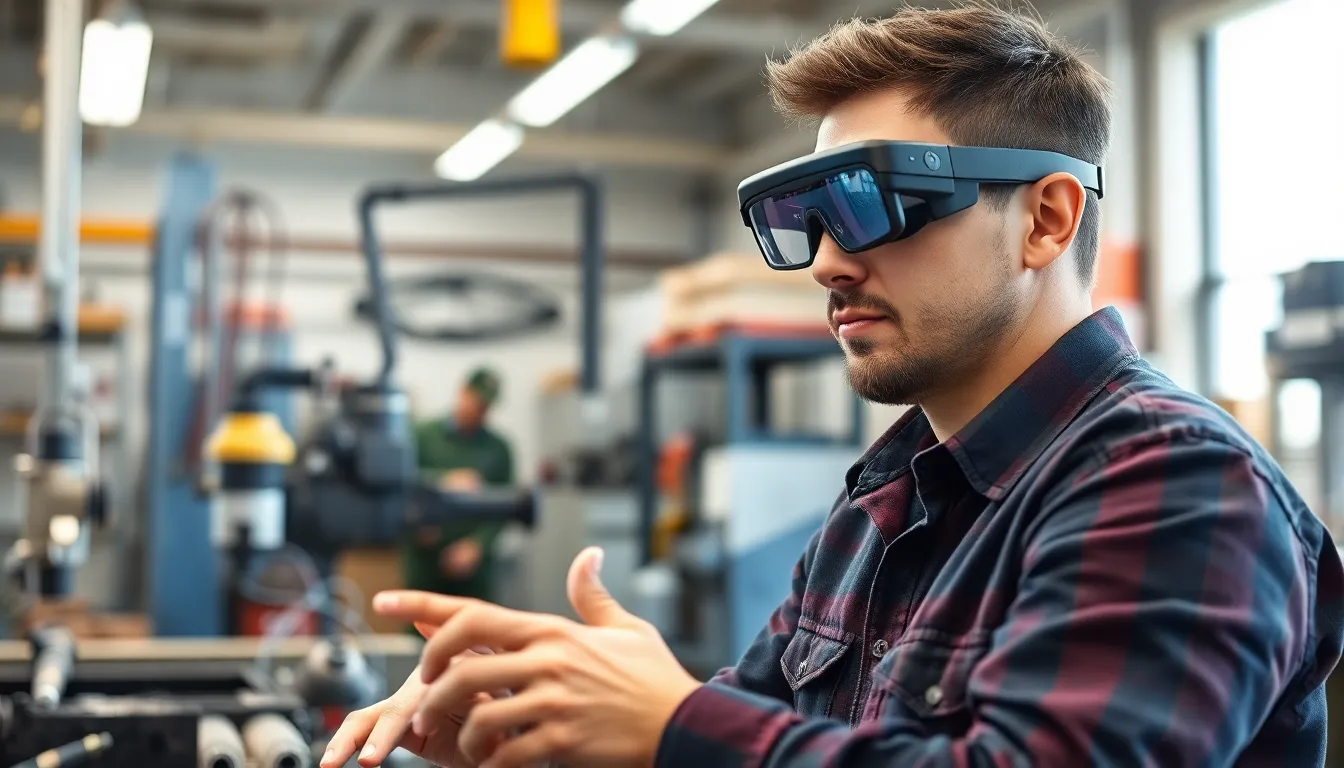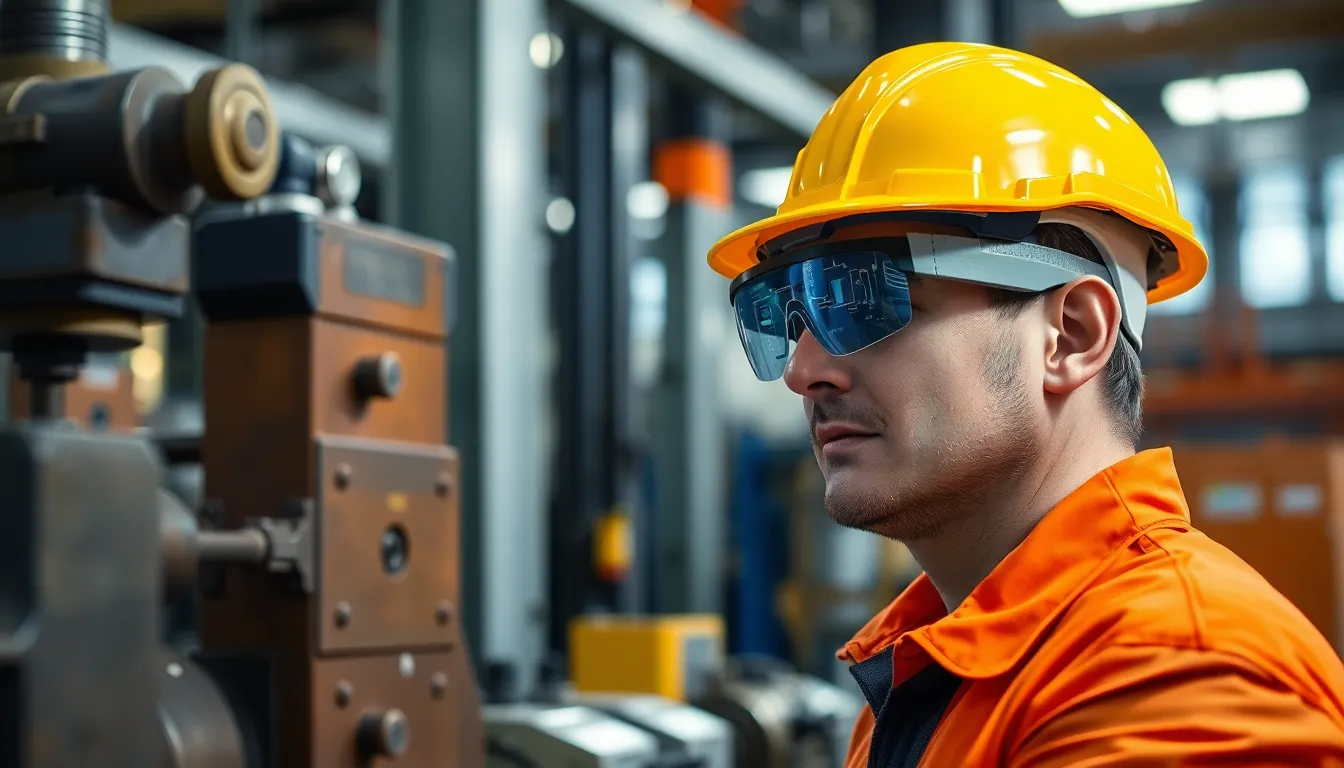Imagine trying to fix a complicated machine while your expert buddy is thousands of miles away, sipping coffee in their pajamas. Sounds like a recipe for disaster, right? Enter AR remote assistance, the superhero of the tech world. This game-changing technology lets users connect with remote experts in real-time, overlaying helpful visuals right onto the problem area. It’s like having a tech-savvy sidekick who can point out what you’re doing wrong without the risk of them spilling coffee on your equipment.
With AR remote assistance, businesses can save time, cut costs, and avoid the hassle of unnecessary travel. Whether it’s troubleshooting machinery or guiding a customer through a complex setup, this innovative approach turns frustration into efficiency. It’s not just about fixing problems; it’s about transforming how we work together, one virtual headset at a time. Who knew remote help could be so cool?
Table of Contents
ToggleOverview of AR Remote Assistance
AR remote assistance transforms how organizations provide support. This technology allows real-time connections between field technicians and remote experts through augmented visuals. Users benefit from enhanced problem-solving capabilities without requiring physical presence at the location.
In practical applications, AR remote assistance supports maintenance tasks, training programs, and troubleshooting scenarios. During a maintenance task, for instance, experts can overlay instructions directly onto the equipment, guiding technicians step by step. This capability reduces the time spent on resolving issues since immediate guidance becomes accessible.
Organizations experience significant cost savings when adopting AR solutions. By minimizing the need for travel, expenses related to sending experts on-site decrease. Moreover, teams can solve complex problems faster, resulting in better service delivery.
Training opportunities also improve with AR remote assistance. New employees use AR devices to learn procedures by following visual cues. More experienced workers enhance their skills through interactive learning, leading to increased workforce proficiency.
User engagement benefits from the immersive experiences AR offers. Employees feel more connected to remote experts, fostering teamwork and collaboration despite physical distances. Additionally, the technology is adaptable for various industries, including manufacturing, healthcare, and telecommunications.
According to a study conducted by Deloitte, 80% of organizations implementing AR applications reported increased productivity. As AR remote assistance continues to develop, its effectiveness in enhancing operational efficiency becomes increasingly clear. Businesses looking to adopt innovative solutions find value in this cutting-edge technology.
Benefits of AR Remote Assistance

AR remote assistance offers substantial advantages for organizations, promoting enhanced communication and efficiency. This technology fosters an effective environment for real-time support and learning.
Enhanced Collaboration
Collaboration significantly improves with AR remote assistance. Remote experts and technicians can interact dynamically, sharing insights and visual instructions. Through augmented visuals, they eliminate misunderstandings typically associated with verbal instructions. Effective teamwork develops as both parties engage with the same visual context. This real-time connection not only strengthens relationships but also helps individuals across various sectors build rapport, regardless of their physical locations. Enhanced collaboration leads to quicker resolutions and higher-quality outcomes, which ultimately benefits customer satisfaction.
Improved Efficiency
AR remote assistance accelerates efficiency in troubleshooting and training tasks. By overlaying instructions onto equipment, technicians receive immediate guidance, reducing downtime and speeding up repairs. This guided support minimizes the need for on-site visits, saving valuable resources. Organizations also report faster onboarding of new employees, as AR enables them to grasp procedures quickly. Studies indicate that businesses utilizing AR experience notable reductions in error rates and resolution times. Increased productivity becomes a natural result when teams work cohesively using visual aids. Overall, improved efficiency translates directly to better service delivery and enhanced operational outcomes.
Applications of AR Remote Assistance
Augmented reality remote assistance sees diverse applications across various fields. Organizations leverage this technology to enhance productivity and improve operational efficiency in multiple areas.
Education and Training
AR remote assistance streamlines education and training processes for organizations. Training modules benefit from immersive experiences, enabling learners to visualize complex concepts through AR interfaces. These systems allow instructors to provide real-time feedback, enhancing engagement during lessons. For instance, employees can practice procedures on virtual equipment, fostering confidence without risks of real-world mistakes. A study by TechSmith found that 67% of employees prefer AR training methods, showcasing the preference for interactive learning environments, which significantly boosts retention rates and reinforces skills.
Industrial Maintenance
Industrial maintenance utilizes AR remote assistance to increase efficiency and reduce downtime. Technicians receive visual overlays of equipment, guiding them through repair processes directly on-site. Experts can support field workers remotely by sharing instructions, minimizing travel and associated costs. The use of augmented visuals creates a more intuitive experience for technicians. A report by PwC indicates that up to 40% reduction in maintenance time occurs when AR technology is implemented, highlighting its effectiveness in troubleshooting and repairs while enhancing overall productivity.
Healthcare
Healthcare experiences significant improvements through AR remote assistance, particularly in surgical procedures and patient care. Surgeons can access critical data and overlay essential information during operations, enhancing decision-making. Remote specialists provide live support, allowing for collaborative diagnostics or guidance in real-time as well. Nurses benefit from AR training scenarios, preparing them for various situations encountered in patient care, leading to better outcomes. According to a study by Accenture, adopting AR solutions can reduce errors in medical settings by up to 30%, ensuring higher quality patient care and safety.
Challenges in AR Remote Assistance
Despite its advantages, AR remote assistance faces challenges that organizations must address. Technical limitations and user adoption issues hinder widespread implementation.
Technical Limitations
Technical limitations pose significant hurdles for AR remote assistance. Bandwidth issues affect real-time visual streaming, leading to lag and connectivity disruptions. Device compatibility must be considered; not all users have access to the latest AR hardware, limiting engagement. Limited field of view in some devices restricts the amount of information displayed, impacting effectiveness. Furthermore, costs associated with implementing AR solutions can be substantial, making it difficult for smaller organizations to adopt these technologies. Addressing these limitations is essential for organizations seeking to leverage AR fully.
User Adoption
User adoption represents another critical challenge in AR remote assistance. Resistance to change commonly arises among employees accustomed to traditional support methods. Proper training remains necessary; without it, users may struggle to grasp the full benefits of AR technology. Additionally, the perceived complexity of AR systems can discourage use, leading to lower integration rates. Organizations must promote the advantages of AR remote assistance to foster acceptance. Engagement strategies that involve pilot programs and clear communication can help improve adoption rates and facilitate a smoother transition to AR technologies.
Future Trends in AR Remote Assistance
Emerging trends in AR remote assistance highlight its potential for transformative applications. Predictive analytics integration into AR systems allows organizations to anticipate issues before they arise. Users can receive proactive support, improving maintenance practices and operational efficiency.
Advancements in artificial intelligence augment AR capabilities. AI-driven AR applications can intelligently analyze the context of tasks, guiding users with tailored instructions. Real-time data analytics enhances decision-making processes for technicians and remote experts.
Wearable devices are becoming increasingly popular in AR remote assistance. Smart glasses offer hands-free experiences, allowing technicians to access information while working. Voice recognition technology facilitates interactions, making the overall process more seamless and user-friendly.
Increased focus on cybersecurity is crucial for protecting sensitive data during AR sessions. Organizations need to implement robust security measures to ensure that remote assistance remains safe and reliable. Data encryption and secure authentication methods can safeguard communication between users.
Cross-industry collaborations will trend as more companies recognize the value of AR remote assistance. Partnerships between tech developers and specific industries foster innovation, creating tailored solutions. For instance, collaborations in healthcare can lead to improved surgical training tools.
Finally, the expansion of 5G networks significantly impacts AR remote assistance. Low latency and high-speed connections enable more fluid interactions between users and remote experts. This connectivity empowers organizations to deploy AR technologies on a larger scale, enhancing accessibility and functionality.
AR remote assistance is revolutionizing how organizations approach support and training. By bridging the gap between remote experts and field technicians, it enhances efficiency and collaboration. The ability to overlay critical information in real-time not only accelerates problem-solving but also improves training outcomes.
While challenges like technical limitations and user adoption persist, the benefits far outweigh the hurdles. As technology continues to evolve, AR remote assistance is poised to become an essential tool across various industries. Embracing this innovation can lead to significant operational improvements and a more skilled workforce, ultimately driving better service delivery and customer satisfaction.



